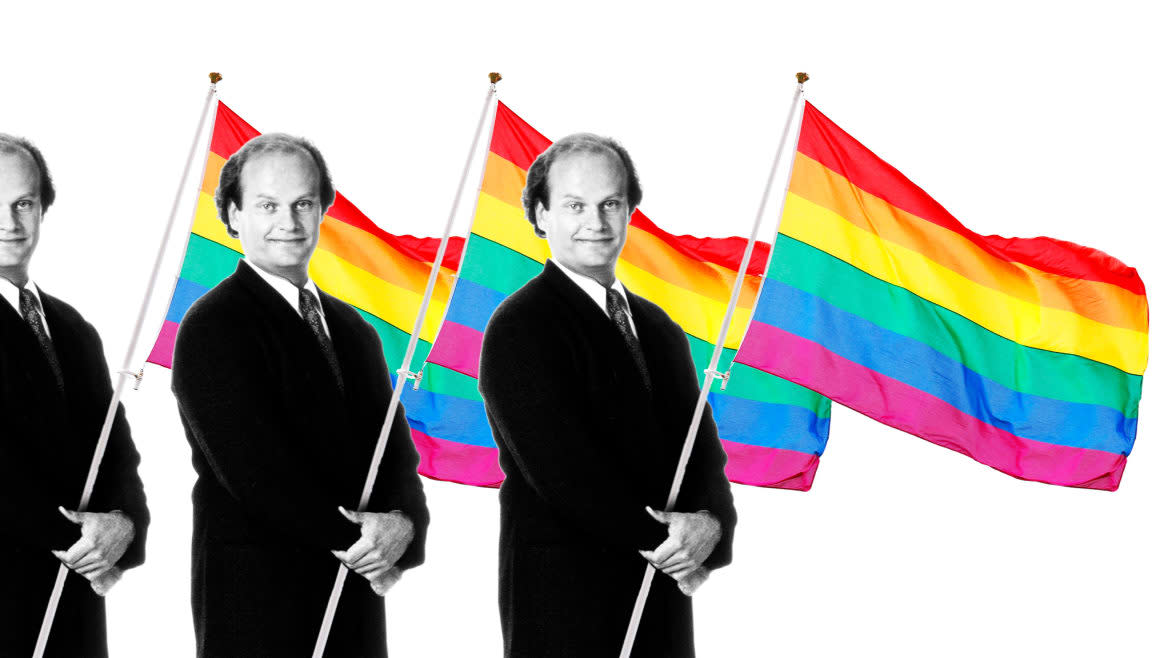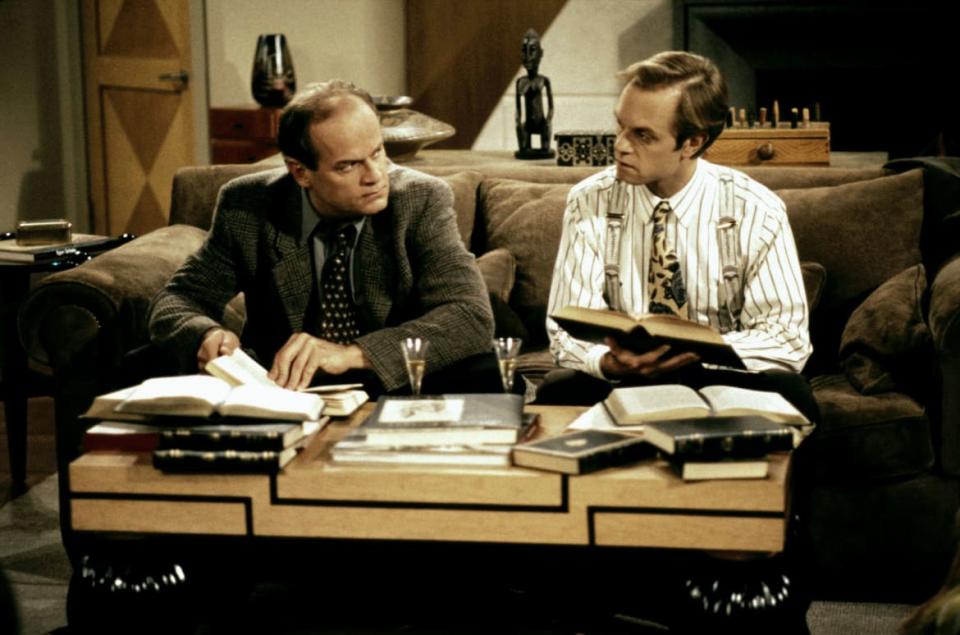‘Frasier’ Was a Gay Show for Straight People—And That’s What Made It So Great

- Oops!Something went wrong.Please try again later.
In a season 15 episode of The Simpsons, Marge Simpson famously voiced a then-prevailing sentiment about Sex and the City, that the taboo-busting dramedy was a queer Trojan horse. “That’s the show about four women acting like gay guys,” she remarked. But if the HBO series used its brunch-loving foursome as stand-ins for modern queer life, a similar sentiment could be voiced about Frasier, the acclaimed ’90s sitcom about a self-involved therapist and his close inner circle. The series was recently resurrected for a suspiciously straight sequel on Paramount+, but in its original run, Frasier was deliciously queer—frequently using its characters’ heterosexuality to comment on stereotypes and evolving cultural norms surrounding LGBTQ+ people. Frasier was for the gays, even if its characters happened not to be.
For the uninitiated, it’s almost impossible to describe what makes Frasier, which aired for 11 seasons on NBC before wrapping in 2004, so unmistakably queer. At first glance, the show is as straight as it gets: Frasier was spun off from Cheers, a long-running sitcom set in the eponymous Boston straight bar, where the titular Frasier Crane (Kelsey Grammer) was a regular. But despite its setting, Cheers was surprisingly progressive, devoting a Season 1 episode to critiquing its characters’ homophobia, and that same ethos is key to Frasier’s origin story. Although the series was initially slated to be set in Denver, producers opted to change the location of Frasier’s hometown to Seattle after Colorado passed a controversial law banning cities from passing pro-LGBTQ+ civil rights ordinances. The show’s decision was a critical piece of a boycott co-signed by celebrities like Madonna and Whoopi Goldberg, which ultimately cost Colorado millions in lost revenue prior to the 1992 statute being struck down in court.
It would be incorrect to define the show’s efforts as mere allyship—straight people demonstrating their support for the LGBTQ+ community; they feel more akin to membership. Frasier is deeply rooted in the queer traditions of the comedy of manners, a genre of satirical comedies critiquing the conventions of modern society that dates back to 17th-century Britain. The comedy of manners experienced a 20th-century resurgence through the work of gay playwright Noël Coward, whose plays go as far as the era would allow in openly recognizing his characters’ queerness. It wasn’t until a 2001 restaging of Coward’s divine Design for Living—which starred actors Dominic West and Alan Cumming as two sides of a bisexual love triangle—that the characters’ sexualities became text, rather than knowing innuendo. While it would be a mistake to claim that the characters in Frasier are actually gay, the show shares a similar lens: It’s a screwball comedy about hapless straight people as viewed through queer eyes.

But what makes Frasier different from the traditional comedy of manners is that it was able to openly discuss the subject of homosexuality due to changes in so-called “public decency” laws—and very often did. The queer centerpiece of Frasier’s original run is a trio of episodes known among fans as the Gay Trilogy: “The Matchmaker,” “Out With Dad,” and “The Doctor Is Out.” Each written by out gay staff writer Joe Keenan, their respective plots are prototypical Frasierian farces, involving a series of miscommunications and false assumptions that blow up in spectacular fashion. In “The Matchmaker,” Frasier winds up on a date with a new hire at KACL, whom he does not realize is gay. “Out With Dad” is similar, except that Frasier’s curmudgeonly father, Martin (John Mahoney), is the one falsely set up with another man: the spray tanned uncle of Frasier’s comely opera crush (Marg Helgenberger). The gay mishaps wrap with “The Doctor Is Out,” in which Frasier encourages the attention of a handsome opera director (Patrick Stewart) after he finds that being in a high-profile queer relationship comes with unexpected local celebrity.
‘Frasier’ Just Isn’t the Same without Niles and Marty
What makes these episodes hold up so well is the respect and care they show for their LGBTQ+ characters, whom Keenan is keen on ensuring are not the butt of the joke. A great example is “Out With Dad,” in which Martin doesn’t have the heart to tell his date that he’s straight for an unexpected reason: It’s not that Martin is embarrassed by the mixup but that he doesn’t want to hurt the other man’s feelings. As an elderly widower, Martin knows what it’s like to feel alone. Unlike its NBC sitcom contemporary Friends, in which the very suggestion of homosexuality induces instant hysteria, Frasier isn’t written from a defensive posture, as if it intends to prove something. Of the gay shenanigans in “The Matchmaker,” Vulture’s Bethy Squires similarly notes a “complete lack of gay panic” in Frasier’s realization of his coworker’s interest: “He doesn’t cast Tom as a predator for hitting on him. It’s just another faux pas in Frasier’s life, probably below picking the wrong wine to pair with fish.”

The tenderness that Frasier extends its LGBTQ+ characters is due not only to the quality of its writing but also to the plethora of queer people represented in virtually every aspect of the show’s production. Fan-favorite Niles Crane, Frasier’s love-lorn brother, was embodied by gay actor David Hyde Pierce, who slyly came out in a 2007 CNN interview by name-dropping his partner. Actors Dan Butler, who portrayed KACL’s womanizing sports host Bob Briscoe, and Edward Hibbert, who played closeted food critic Gil Chesterton, were out during the show’s airing, although the fact drew little notice at the time. During Frasier’s ninth season in December 2001, Hibbert confessed to LGBTQ+ magazine The Advocate that he never told his family that he’s gay because they already knew: “I think in England it’s not the same. It’s unspoken but understood.” Frasier’s gay brain trust also included executive producer David Lee and the late Mahoney, who never discussed his personal life openly prior to his 2018 death.
With so many gay men at the helm of Frasier, the show never stoops to easy homophobic punchlines, instead giving its queer characters the agency to be part of the action. They are not passive objects of others’ disdain but permitted to be ridiculous on their own accord, as silly and absurd as the other players in the comedy unfolding around them. In one of the show’s most enduringly hilarious episodes, “Ham Radio,” Frasier stages a classic murder mystery for KACL listeners, only to have the program derailed by his directorial megalomania. The best scene is one in which Gil protests his big speech being cut—in which his character waxes nostalgic about a homoerotic boyhood—by reading the monologue anyway. Frasier, thinking on the fly, kills Gil’s character live on air, only for Gil to keep popping back in to continue the speech, offed over and over again. Although Frasier occasionally has its fun with the tension between Gil’s sham marriage to an unseen wife and his worldly flamboyance, the joke here isn’t that he is gay but that he won’t follow the script.
True to its generic lineage, the gay comedy of manners in Frasier is less about the LGBTQ+ community itself than how we perceive queerness and what that says about us as a society. In “The Doctor Is Out,” Niles and Frasier are convinced that the new boyfriend of Frasier’s amorous boss, Roz (Peri Gilpin), is gay, but Martin points out that his sons are enforcing an unfair double standard: They are straight guys who enjoy expensive wine and fine dining, interests that others might lazily believe are exclusively homosexual. Why is their heterosexuality beyond reproach, Martin asks, while other men are subject to scrutiny? The ultimate punchline of “The Matchmaker” is not what Frasier assumes about his coworker but what Tom presumes about him. After Frasier confesses that he never once thought that the station’s new hire might be gay, the unspoken assertion being that queerness is something one can plainly “tell,” Tom turns the tables on the cliché. “Well, it never even occurred to me that you might be straight,” he responds.
The Bizarre, Brilliant Meme-ification of ‘Frasier’
Frasier’s “Gay Trilogy,” the recipient of numerous awards at the time they were broadcast, is now understood to be an interrogation of its own audience. Niles’ romantic arc is centered on his long-simmering feelings for Daphne (Jane Leeves), his father’s British housekeeper, and yet many viewers of the time were convinced that the other Dr. Crane simply must be gay. Pierce, who won four Emmys for the performance, plays Niles as a snob and a fop, and the show appears to take a similar position to Martin on the subject: Why can’t a dandy be straight? Can’t heterosexuals be pretentious, too? Pierce would discuss the show’s approach to his “neat and persnickety” character in a 2015 interview with HuffPost Live, confirming that the goal was always to question why we as a society typecast others into the roles we do. “It was never jokes at the expense of gay people,” he said. “It was always acknowledging the preposterousness of stereotypes.”

If Frasier was a gay show about straight people, it’s a shame then that its sequel is sadly light on gay hijinx. Frasier’s core queer cast did not return for the reboot, which sees its protagonist move back to Boston for a coveted teaching position at Harvard, focusing on Frasier’s relationship with his estranged son, Freddy (Jack Cutmore-Scott). The gleefully effete sensibilities of the show’s predecessor are in short supply, opting for brightly lit sets that resemble The Big Bang Theory to exploit nostalgia for ’90s sitcoms. Frasier, though, was so much more than a laugh track: It was vastly ahead of its time in depicting the existence of queer people as just another facet of everyday life, just as vain and self-interested as everyone else. The new Frasier is still early in its run, airing just four episodes thus far, so here’s hoping that the series rediscovers that old gay magic.
Keep obsessing! Sign up for the Daily Beast’s Obsessed newsletter and follow us on Facebook, Twitter, Instagram and TikTok.
Get the Daily Beast's biggest scoops and scandals delivered right to your inbox. Sign up now.
Stay informed and gain unlimited access to the Daily Beast's unmatched reporting. Subscribe now.

